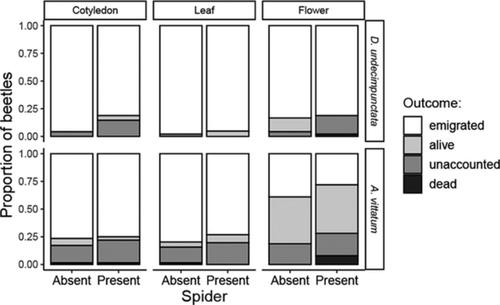当前位置:
X-MOL 学术
›
Ann. Appl. Biol.
›
论文详情
Our official English website, www.x-mol.net, welcomes your
feedback! (Note: you will need to create a separate account there.)
Consumptive and non‐consumptive effects of wolf spiders on cucumber beetles and cucumber plant damage
Annals of Applied Biology ( IF 2.2 ) Pub Date : 2020-09-20 , DOI: 10.1111/aab.12643 Hanna M. Kahl 1 , Alan W. Leslie 1 , Cerruti R.R. Hooks 1
Annals of Applied Biology ( IF 2.2 ) Pub Date : 2020-09-20 , DOI: 10.1111/aab.12643 Hanna M. Kahl 1 , Alan W. Leslie 1 , Cerruti R.R. Hooks 1
Affiliation

|
Biological control research often focuses on the ability of predators to reduce pest densities and protect crops through consumption. Less studied is their ability to protect crops by altering pest behaviour (non‐consumptive effects). Lab experiments were conducted to test predation rates of striped cucumber beetles (Acalymma vittatum; Coleoptera: Chrysomelidae) and spotted cucumber beetles (Diabrotica undecimpunctata howardi; Coleoptera: Chrysomelidae) by large (>10 mm) wolf spiders (Araneae: Lycosidae). Field experiments were conducted to examine how the physical presence and/or cues of spiders impact the behaviour and mortality of A. vittatum (specialist) and D. undecimpunctata (generalist) cucumber beetles as well as growth and damage of cucumber plants (Cucumis sativus; Cucurbitaceae). A. vittatum and D. undecimpunctata adults were added to caged cucumber plants without a spider, with spider cues only (spider removed before beetle inclusion), with spider only (spider introduced to plants immediately before beetle inclusion), and with spiders and their cues present (spiders introduced 24 hr in advance of beetle inclusion). A. vittatum responded to spider cues primarily by emigrating from plants. Contrarily, D. undecimpunctata did not display obvious responses, such as reduced feeding or increased emigration, to spider foraging and/or cues. Actively foraging lycosids increased A. vittatum mortality and reduced densities of D. undecimpunctata in the field when cucumber plants were flowering. This study highlights how non‐consumptive and consumptive effects can play a role in modifying pest populations, and how these effects can vary across species and plant growth stages.
中文翻译:

狼蛛对黄瓜甲虫和黄瓜植物危害的消费和非消费效应
生物防治研究通常侧重于捕食者减少有害生物密度并通过食用保护作物的能力。对它们通过改变害虫行为(非消费性作用)保护作物的能力的研究较少。进行实验室实验以测试大型(> 10 mm)狼蛛(Araneae:Lycosidae)对条纹黄瓜甲虫(Acalymma vittatum ;鞘翅目:葫芦科)和斑点黄瓜甲虫(Dibrotica undecimpunctata howardi)鞘翅目的捕食率。进行了野外实验,以检查蜘蛛的身体形态和/或线索如何影响A. vittatum(专科医生)和D. undecimpunctata的行为和死亡率。(一般)黄瓜甲虫以及黄瓜植物(Cucumis sativus;葫芦科)的生长和损害。将无芒线虫和不带鳞线虫的成虫添加到没有蜘蛛的笼养黄瓜植株中,仅带蜘蛛线索(在甲虫包涵之前除去蜘蛛),仅带蜘蛛(蜘蛛将虫引入甲虫之前立即引入植物),并带有蜘蛛及其线索。目前(蜘蛛在引入甲虫之前24小时引入)。A. vittatum主要通过从植物移出来对蜘蛛线索做出反应。相反,去皮衣原体对蜘蛛觅食和/或线索没有表现出明显的反应,例如进食减少或移出增加。积极觅食的类固醇增加当黄瓜植物开花时,田间的A. vitatum死亡率和密度降低的D. undecimpunctata。这项研究强调了非消费和消费效应如何在改变害虫种群中发挥作用,以及这些效应在物种和植物生长阶段之间如何变化。
更新日期:2020-09-20
中文翻译:

狼蛛对黄瓜甲虫和黄瓜植物危害的消费和非消费效应
生物防治研究通常侧重于捕食者减少有害生物密度并通过食用保护作物的能力。对它们通过改变害虫行为(非消费性作用)保护作物的能力的研究较少。进行实验室实验以测试大型(> 10 mm)狼蛛(Araneae:Lycosidae)对条纹黄瓜甲虫(Acalymma vittatum ;鞘翅目:葫芦科)和斑点黄瓜甲虫(Dibrotica undecimpunctata howardi)鞘翅目的捕食率。进行了野外实验,以检查蜘蛛的身体形态和/或线索如何影响A. vittatum(专科医生)和D. undecimpunctata的行为和死亡率。(一般)黄瓜甲虫以及黄瓜植物(Cucumis sativus;葫芦科)的生长和损害。将无芒线虫和不带鳞线虫的成虫添加到没有蜘蛛的笼养黄瓜植株中,仅带蜘蛛线索(在甲虫包涵之前除去蜘蛛),仅带蜘蛛(蜘蛛将虫引入甲虫之前立即引入植物),并带有蜘蛛及其线索。目前(蜘蛛在引入甲虫之前24小时引入)。A. vittatum主要通过从植物移出来对蜘蛛线索做出反应。相反,去皮衣原体对蜘蛛觅食和/或线索没有表现出明显的反应,例如进食减少或移出增加。积极觅食的类固醇增加当黄瓜植物开花时,田间的A. vitatum死亡率和密度降低的D. undecimpunctata。这项研究强调了非消费和消费效应如何在改变害虫种群中发挥作用,以及这些效应在物种和植物生长阶段之间如何变化。











































 京公网安备 11010802027423号
京公网安备 11010802027423号